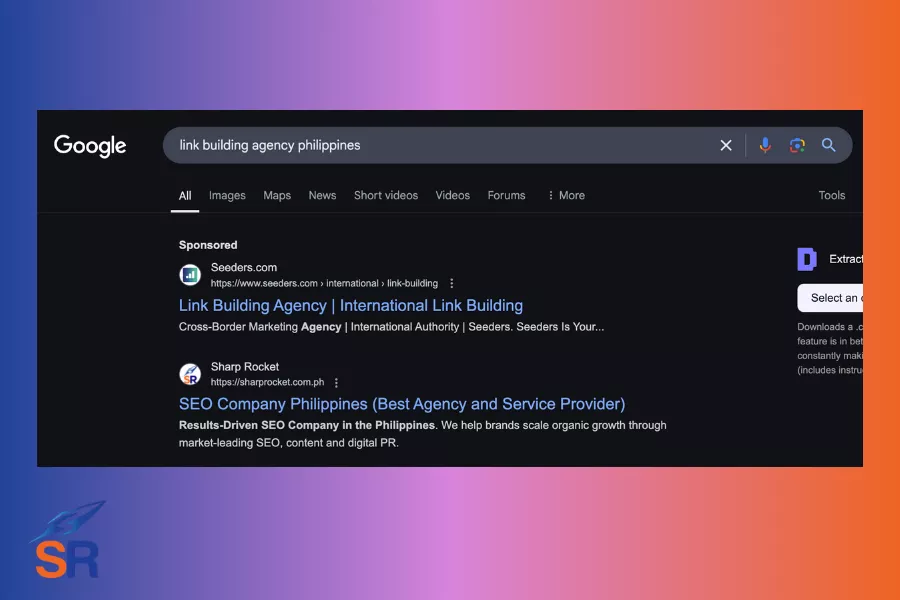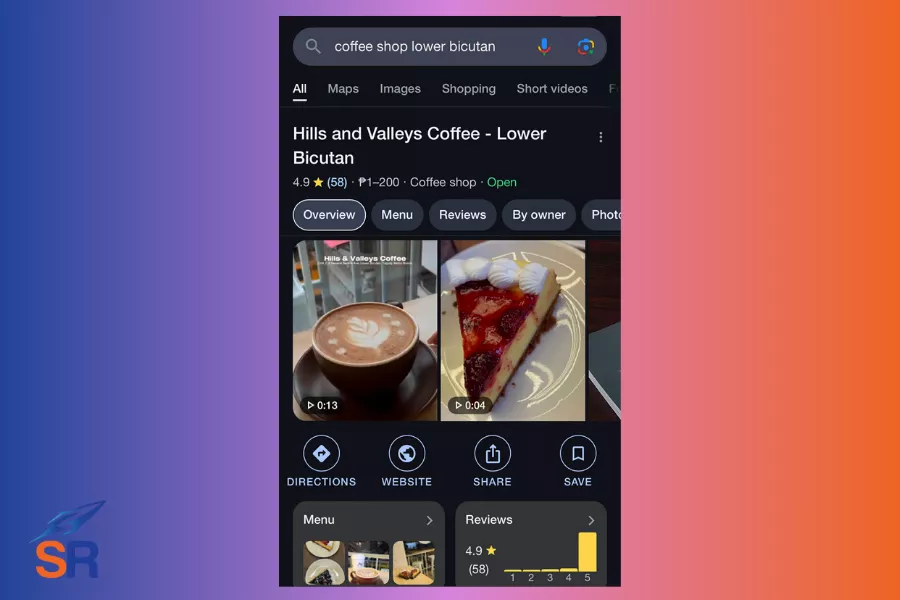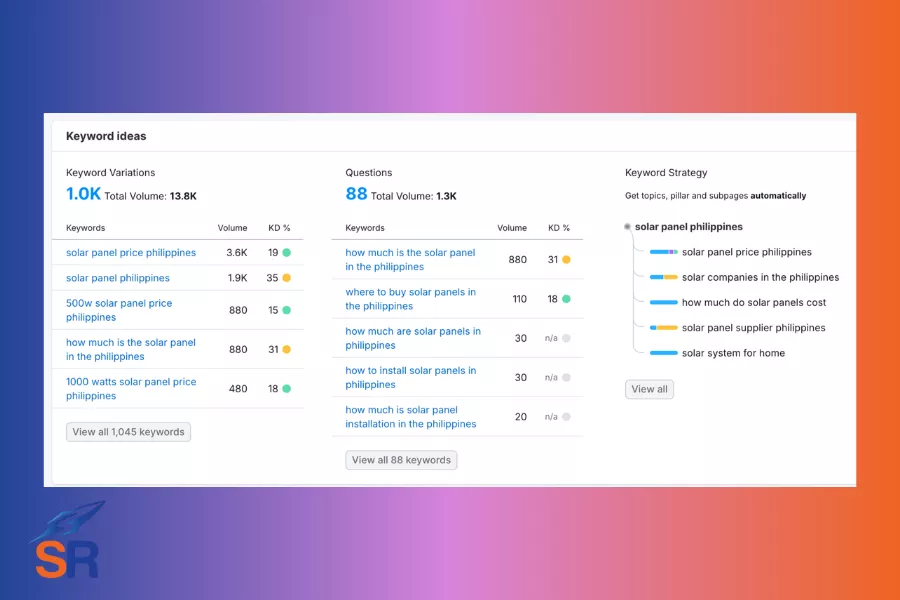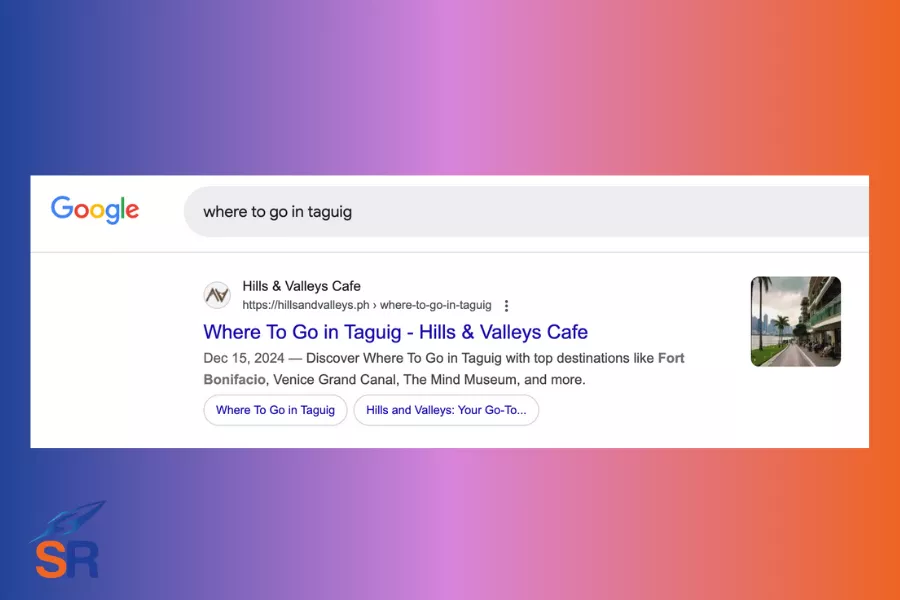by Venchito Tampon Jr | Last Updated on March 27, 2025
The Philippine SEO market is ripe for new businesses to promote their products or services by ranking for industry-related keywords to increase their website’s organic traffic and leads.
With more Filipinos using Google to find nearby stores, restaurants, clinics, and services, local SEO in the Philippines has become a key strategy for business growth.
If your business depends on foot traffic, deliveries, or local word-of-mouth, learning how to do local SEO in the Philippines can give you an edge over your competitors.
As many digital marketers are overly focused on paid advertising, such as meta ads, there’s room for any business owner to get traffic from a channel most businesses overlook.
By definition, local SEO is the process of improving your brand’s visibility on Google for searches in a specific area. Unlike regular SEO, local SEO focuses not just on website rankings but also on appearing in the local map packs, which are the top 3 business listings that show up at the top of search results with a map.
It helps your business gain the necessary visibility at the top of local business map packs displayed on top of organic search results pages.
I have my fair share of rankings for local keywords for my own businesses, including our coffee franchise, corporate training company, and our SEO agency, which ranks #1 for “link building agency Philippines.”

This guide covers practical, actionable SEO strategies to help you appear in local map packs and organic search listings. And it’s now the right time for local businesses to jump into local SEO and capture traffic their competitors may have missed.
1. Optimize Your Google Business Profile
One of the first high-impact techniques for a local SEO campaign is optimizing your Google Business Profile (GBP). Your GBP is often the first thing people see when they search for a service near them.
Most local businesses in the Philippines don’t recognize the power of GBP in proportion to how it could drive nearby customers to visit their local businesses. While they could easily set up Facebook, Instagram, and TikTok profiles, most local businesses don’t have verified Google Business Profiles.

Here are a couple of tips to start verifying and optimizing your Google Business Profile:
- Claim and verify your business. Go to Google Business Profile and claim your listing. To activate your profile, complete the verification process (via mail, email, phone, or video).
- Fill out all core details. Enter accurate and consistent business information (NAP – Name, Address, and Phone Number), your website URL, business hours, and service area.
- Choose your most accurate category. Your main category tells Google what your business does. For instance, use “dental clinic” if you offer multiple services, but use “orthodontist” if you specialize in braces. You can also add secondary categories to support your other services.
- Write a clear business description that explains what you do, who you serve, and what makes your business unique. You can include local keywords naturally (e.g., “We are a family-owned Filipino bakery in Pasig, offering fresh pandesal, custom cakes, and coffee since 2002.”).
- Add high-quality photos that include your storefront and signage, interior or workspace, products or services in action, and staff or team members (these photos help improve trust and engagement, getting more clicks and direction requests).
- Enable messages if you want your customers to message you directly from search results.
- Ask customers to leave reviews on your Google Business Profile. You can also strategically place a QR code on your store to solicit reviews.
- Update your Google Business profile regularly by posting new offers, products, events, announcements, or tips. This sends rich local signals to Google about your profile’s recent activities.
- If you change due to holidays or special events, update your business hours beforehand.
This list alone is enough to help you increase your Google Business Profile’s local visibility. Completing and verifying your Google Business Profile should only take a few days, but you’ll get high returns from this low-effort local SEO strategy.
2. Know Your Offer and Choose the Right Keywords
Local keyword research is one of the first and most critical steps in SEO. Before optimizing your website, fixing technical SEO issues, or building backlinks, you need to understand what your potential customers are actually typing into Google.
Search engines use keywords to match search queries to relevant businesses. If you don’t use the right keywords, especially those with local intent, your business might not show up, even if your service is exactly what the user wants.
Start by clearly defining what you offer. Are you a café, a freelance web designer, a cleaning service, or a dental clinic? Then, specify your ideal customer and their location (you may probably know this at the start). These answers will certainly guide everything else in your local SEO strategy.
To top all the reasons why you need keyword research, you must uncover search terms only relevant to your business. Given that you may end up getting irrelevant traffic (as you could be ranking for other industry keywords) or get thousands of search traffic, but few actually convert into actual customers.
Here are actionable tips to help you find keywords relevant to your business.
List Down Your Services and Match with Local Search Terms
If your business offers multiple services, create a list of your offers and match them with possible location-based keywords. Here are some examples:
Use Google Autocomplete
Go to Google and type in your main product or service. Don’t press enter. Just look at the dropdown suggestions.
These may reflect actual user searches. For instance, as I type the keyword “laundry service”, it shows autocomplete search terms such as “laundry service Quezon City”, “laundry service BGC”, or “laundry service Cubao”.
Use Freemium SEO Tools
You can use free SEO tools such as Google Keyword Planner, UberSuggest, and AnswerThePublic to find keywords and questions people usually search for in your local area.
If you have an extra budget, you can use paid tools such as Ahrefs or SEMRush to get keyword data with relevant search volume and keyword difficulty. These two metrics can help you decide if the specific keyword is worth optimizing pages to rank for.

You can also enter your competitors’ domains in Ahrefs or SEMRush to see what keywords they’re currently ranking for, which helps you generate more keyword ideas you could potentially rank.
Pro Tip: There may not be enough search volume for your target keywords for tightly niche industries. However, if your customers are searching for them to find solutions to their needs, it’s worth giving a try to create content and optimize them for those keywords (or questions).
3. Create Dedicated Landing Pages for Target Keywords
You can’t rank for a keyword unless you have a dedicated page that’s optimized for such a keyword.
Every keyword you want to rank for should have its focused landing page (1-to-1 keyword for each landing page). Doing so, you help search engines better understand precisely what your page is about (“topical relevance”) and gives users a better experience by showing them what they need with the content that matches their search.
The best part about how SEO has evolved is that Google now understands a page’s relevance through keywords, context, and user intent. It can recognize the meaning and sentiment behind your content, helping pages rank when they match what people are looking for, even if the exact keyword isn’t repeated many times.
Let’s examine one example. Avoid putting everything on one page if you serve multiple locations or offer different services. Instead, build a separate page for each area or offering.
| Service | Keyword Ideas |
|---|---|
| Aircon Cleaning | aircon cleaning Makati, aircon service Quezon City |
| Home Massage | home massage Manila, on-call massage Ortigas |
| Dog Grooming | dog grooming Taguig, pet grooming near me BGC |
Google ranks pages, not the whole website. So, if someone searches for “aircon repair Makati,” it will favor a page specifically about “aircon repair in Makati,” not a general page listing 10 cities.
I did the same for my coffee shop locations. I created a /locations page that lists the areas we serve, with links to each local page. This helps users find our brand location easily instead of mixing service and city in every URL, keeping these URLs organized and clean.
4. Add LocalBusiness Schema Markup
Adding your business name, address, and phone number (NAP) to your website is essential, but it is not enough. While your users can read this information, search engines need to understand that your NAP is official business data and not just regular text. That’s where LocalBusiness Schema markup comes in.
LocalBusiness schema markup is a type of structured data that uses a standardized format (usually JSON-LD) to describe key business details in a way that search engines can quickly process and trust.
When Google sees this structured information, it gains confidence in your legitimacy and local relevance, improving your website’s chances of showing in local map packs and rich search results.
If you can write HTML, follow the instructions on Schema.org. For non-coders, there are WordPress plugins to assist you with implementation.
After adding the schema, use Schema Markup Validator to check if it’s working. If there are errors, fix them immediately.
5. Increase Local Relevance with Informational Content
Google favors businesses that offer more than just sales content. By covering a wide range of useful, related topics for your local audience, you send strong signals that your site is a trusted resource in your niche.
Keeping your website fresh with informational content helps acquire search traffic by ranking for top-of-the-funnel keywords. It shows Google that you’re actively maintaining your site with helpful content that satisfies local search intent.

For instance, if you run a hotel in Ortigas, don’t limit your content to booking pages and room descriptions. Publish helpful, location-specific content that serves potential guests and fulfills their searchers’ needs.
You can publish local guides, such as:
- “Top 10 Restaurants Near Our Hotel in Ortigas”
- “Where to Go for Nightlife in Ortigas After Check-In”
- “Weekend Itinerary: 2 Days in Ortigas from Our Hotel”
These content pieces will help you rank for searches like “restaurants near Ortigas hotels”, “Ortigas travel guides”, or “things to do in Ortigas this weekend”. Local people who are on the verge of looking for potential hotels to check in or are within the area may end up checking your booking page and potentially turn into guests.
Another way to increase your site’s local relevance is to create an FAQ section that answers real questions people ask before booking. It increases your chances to rank for long-tail, location-based searches and brings visitors close to their buying decisions.
Examples are:
- “How far is the hotel from SM Megamall?”
- “Do you offer free parking in Ortigas?”
- “Can I check in early if I arrive from NAIA?”
6. Optimize Pages for Local Search with On-Page SEO
Basic optimization must be put in place when running a local SEO campaign. Part of the essentials is including the keyword in key elements of the webpage.
Starting with the title tag, you must include your target keyword with the target location. Make sure you have a title that clearly states what service or product you offer and where (e.g., “Budget Hotel in Ortigas | Book Now at [Hotel Name]”).
While not considered a direct ranking factor, meta description can influence clicks. Google actually bolds the geographic location when it matches the search query.
When writing a meta description, focus on clarity and have a strong call-to-action (CTA) (e.g., “Stay near SM Megamall at [Hotel Name] in Ortigas. Affordable rooms, free parking, and easy access to public transport. Book today!”).
Other on-page SEO places where you should include your keyword are H1 text, body text (by sprinkling the target keyword and its keyword variants naturally on your content), and image alt text (describe what’s in the photo while including the service and location).
Do intelligent internal linking to pass link equity across other related webpages. You can use keyword-based anchor text to link to related service pages or location pages. This helps users navigate your website seamlessly through these internal links while reinforcing enough local relevance.
In many best practices in SEO, internal linking is a must-do to get other pages to rank quickly on Google’s SERPs (as pages with significant traffic could help pass more link value to its different internal pages).
7. Build Local Links and Citations
If the above optimization isn’t enough to rank for local keywords in the Philippines, where you’ll likely be competing for mid-level to highly competitive keywords, you need an off-page SEO strategy to get backlinks from sources within the country (.ph websites).
These local backlinks include:
- Local blogs
- Local news websites and publications
- Chamber of Commerce listings
- Philippine business directories (only get the legitimate ones)
- Local schools, NGOs, or event pages
Using this type of links, Google shows that trusted link sources from the Philippines can reference your business and help build your local authority.
Aside from local-specific backlinks, get citations that mention the same business information—name, address, and phone number (NAP). Think of it as your business being listed in multiple places, legitimizing its credibility and trustworthiness.
Common citation sources in the Philippines:
- Google Business Profile
- Facebook Business Page
- Yelp Philippines
- Yellow Pages PH
- Esakay.ph (for transport services)
- Real estate and job directories, depending on your industry
You can use a citation tracker like Whitespark or Brightlocal to monitor where your business is listed, fix incorrect details, and identify new citation opportunities.
If you’re looking for link building services to bolster your pages’ rankings or outsourcing white label SEO, book a strategy call today.
The Author
Venchito Tampon Jr
Venchito Tampon is a Filipino Motivational Speaker, Corporate Trainer, and a Leadership Speaker in the Philippines. He is the CEO and Co-Founder of SharpRocket, a link building agency. With a decade of experience, Venchito has a proven track record of leading hundreds of successful SEO (link builidng) campaigns across competitive industries like finance, B2B, legal, and SaaS. His expert advice as a link building expert has been featured in renowned publications such as Semrush, Ahrefs, Huffington Post and Forbes. He is also an international SEO spoken and has delivered talks in SEO Zraz, Asia Pacific Affiliate Summit in Singapore, and Search Marketing Summit in Sydney, Australia. Check out his other businesses, Hills & Valleys Cafe, Blend N Sips and Saas Pursuit.
How our LINK BUILDING AGENCY builds 250 links/mo consistently using Predictable Link Building Methodology™…
- Using a SIMPLE and PROVEN system
- Using a SCALABLE strategy
- No private blog networks
- No creepy outreach emails
